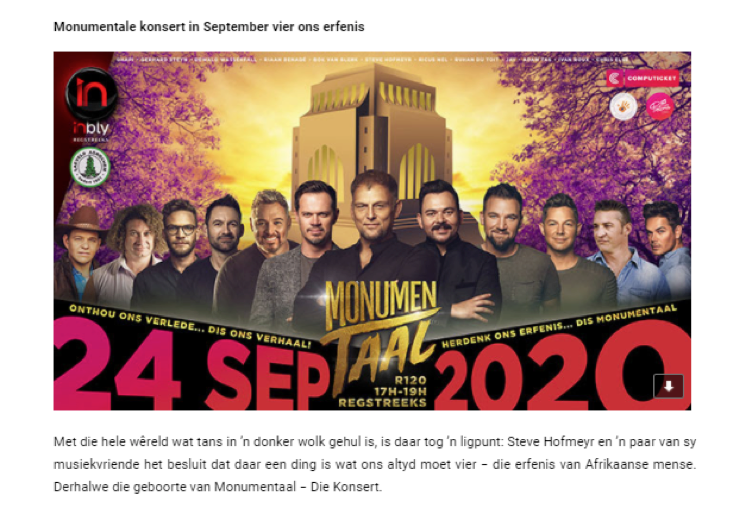The trade union Solidarity has sent out emailers about an online Afrikaans music concert, named “Monumentaal – Die Konsert”, as envisioned by Afrikaans singer Steve Hofmeyr. The concert, hosted on Heritage Day, September 24, is posited as a monumental celebration of “our” heritage – a designation that by implication does not speak to an inclusive South African audience.
While one interpretation of this advertisement and event would maintain it as an innocent and entertaining celebration of cultural identity, several visual codes reach out beyond the frame of the flyer to speak to ideologies still prevalent in popular (and populist) Afrikaans and Afrikaner narratives.
Any ostensibly secure meaning related to “innocent entertainment” is destabilised in an understanding of the relations between this flyer, the event it promotes, and a visualisation of Afrikaner masculinity and heritage as represented in this example.
Three important themes related to Afrikaner nationalism’s social and cultural construction are identified in historical narratives, or rather, in just one narrative, since a singular sanctioned and sanitised version was officially promoted under apartheid rule.
These themes as historically promoted in the propaganda are, first, tales of a “heroic” past. This includes the two most important events in Afrikaner mythology: the Great Trek and the Battle of Blood River.
The second theme is Afrikaner Calvinist religion, constructed and distorted to serve political and patriarchal interests. In the third theme, the Afrikaans language acts as an important signifier of political interests, imbued with religious and material concerns (such as land ownership).
Throughout the twentieth century, but more actively so from the 1930s, these themes aimed to justify the existence of the Afrikaner nation by portraying it not as constructed by its own representations, but as self-evident and inevitable in its characteristics, aspirations and actions. And even though Afrikaner nationalist ideology does not find itself at the head of the South African state anymore, traces of these themes are still identifiable in popular narratives. These range from music videos to arts festivals and include outright propaganda spread on social media to promote what may be dubbed a sense of “suffering for solidarity”. Like light shone through a prism, these themes may have morphed a little, but the discourse they promote is just as exclusionary as it was in the past.
These themes are all represented in visual code in the email flyer. The four most prominent visual elements are the Voortrekker Monument in the central background and the celestial yellow light that surrounds it, the purple flowers of jacaranda trees lining the edges of the background, the line of twelve men bisecting the flyer and separating image from text, and the text outlining the details of the event at the bottom.
The title of the event, “Monumentaal”, translates as “monumental”, but there is a play on words. The emphasis on “taal” (language) establishes this element of cultural identity as central to the concert. This centrality is visually underscored by the placement of “taal” in the bottom centre of the flyer, vertically shared with a photograph of Steve Hofmeyr, the visual apex of the line of men, and the Voortrekker Monument in the background.
Over the past few years, Hofmeyr has established himself not just as an Afrikaans singer to whom this language is important, but also a populist promoter and “fighter” for the language and its material interests (related to land ownership and redistribution). Because of the historical conflation of the Afrikaans language and Afrikaner political interests, Hofmeyr has also become a political figure in a popular narrative, and, due to the historical embeddedness of Afrikaner politics with patriarchal values, a mainstream archetype of Afrikaner masculinity too. Hofmeyr’s near archetypal image is emphasised by the visual placement of his photograph at the tip of a triangular dynamic in the layout, joined at his sides by 11 other white men – visually establishing, in both gendered and racialised terms, 12 disciples of contemporary Afrikaner cultural identity, historically conflated with a Calvinist and male-centred Christian focus. This visual code of masculinity is displayed alongside calls to monumentalism, by implication imbuing conventional characteristics of monuments – strength, stability, permanence – to this version of Afrikaner manhood too.
Including an image of the Voortrekker Monument instead of the Afrikaans Language Monument in a flyer promoting an event seemingly celebrating the Afrikaans language seems incongruous and helps to decode this flyer – and the event – as continuing to promote the previously discussed, politicised themes associated with Afrikaner nationalism.
The Voortrekker Monument holds an important place in Afrikaner mythology. Its foundation stone was laid during an anniversary event of the Battle of Blood River on December 16 1938, after the 100-year commemoration of the Great Trek. Ox-wagon replicas travelled from Cape Town to the former Pretoria for this purpose. Pretoria itself is a significant location in Afrikaner mythology, because it was founded by Voortrekker leader Andries Pretorius, a prominent figure in Battle of Blood River narratives, to be the capital of the then South African Republic. Pretoria, popularly known as the Jacaranda City, is visually represented by the purple jacaranda flowers around the edges of the flyer, separated from the monument by the celestial yellow sky that beams from the monument, literally signified here as a beacon of light.
This heavenly glow emphasises the religiosity of the monument and Afrikaner claims to divine favour, as found in stories like that of the Battle of Blood River. This favour is also visually represented by a light/darkness binary that alludes to religious codes too. It is perpetuated in the text below the visual: “With the entire world currently shrouded in darkness, there is a ray of light: Steve Hofmeyr and a few of his musical friends have decided that there is one thing that should always be celebrated – the heritage of Afrikaans people”.
The yellow text above the date stresses the importance of the Afrikaans language to a construction of an Afrikaner heritage in a rhyme that is lost in translation: “Remember our past… It’s our tale. Commemorate our heritage… It is monumental”.
Highlighting the differences between “history” and “heritage”, David Lowenthal (1998) said heritage is always narrativised with a purpose. Former modes of Afrikaner nationalist mythology are deliberately extended here to mobilise a cultural solidarity by means of a singularised heritage that seems merely entertaining, but functions politically.
With the change to a democratic dispensation in 1994, days of importance to Afrikaner nationalism were not removed from the national calendar entirely, but have been reformulated and interpreted for an inclusionary post-apartheid context. One such example is the Day of the Vow, earlier annually celebrated on December 16 to commemorate the Battle of Blood River, but changed to the Day of Reconciliation after 1994.
Public holidays and their ability to signal heritage and its reformulations have been a contentious topic in South Africa’s recent past, and illustrate Lowentahl’s distinction between history and heritage – arguably none more so than Heritage Day itself.
Since 2005 South Africa’s Heritage Day, formerly celebrated as Shaka Day in KwaZulu- Natal, has been (informally) rebranded to Braai Day in an attempt to use this unifying factor across the country’s races and ethnicities as a tool for nation-building. Organising a concert with an exclusionary focus on Afrikaans as cultural signifier on 24 September signals an obtuse metaphoric resistance to and denial of broader attempts at unified narratives.
This event cannot be read as “mere entertainment”. Such as reading fails due to the relationship between the event, the flyer that promotes it, traces of former state-sanctioned ideologies, and an understanding of Solidarity and Steve Hofmeyr as role-players in this event and its promotion. The Afrikaans language, along with its socio-cultural implications of identity, retrogressively continues to be maintained as something fragile to be defended, with a laager of men and monuments rallying around its edges.




